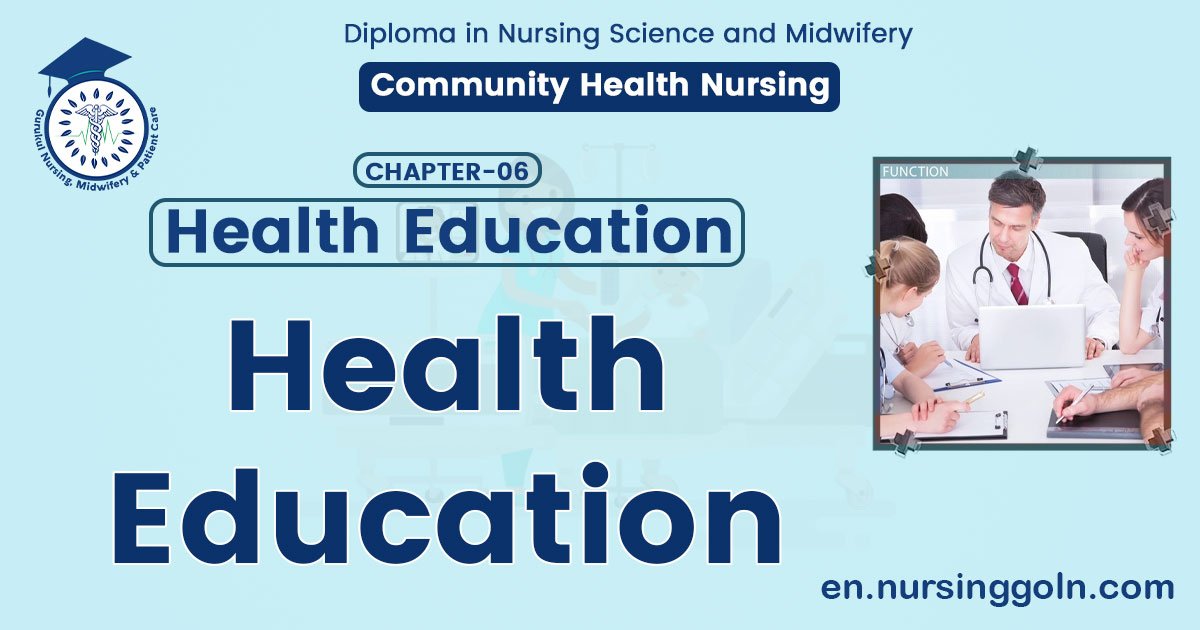Health education – This book covers the entire syllabus of “Community Health Nursing” prescribed by the Universities of Bangladesh- for Basic and diploma nursing students. We tried to accommodate latest information and topics.
This book is examination friendly setup according to the teachers’ lectures and examination’s questions. At the end of the book previous university questions are given. We hope in touch with the book students’ knowledge will be upgraded and flourished. The unique way of presentation may make your reading of the book a pleasurable experience.
Health education
Concepts
Health education is the process of assisting individuals, acting separately or collectively, to make informed decisions on matters affecting individuals, family, and community health. The goal of health education is to help individuals, families, and communities achieve, through their own actions and initiative, optimal states of health and to foster successful changes in health behavior of the individual. Constructing health education lesson plan and practice how to give health education to people are essential for community health nurse as health educator.

Health education
According to World health organization (WHO), “Health education is any combination of learning experiences designed to help individuals and communities improve their health, by increasing their knowledge or influencing their attitudes”.
Or
Health education, according to Green and Kreuter (1991), is planned educational intervention aimed primarily at the voluntary actions people can take on their own (individually or collectively) as citizens looking after their own health or as decision makers looking after the health of others and the common good of the community.
Or
Health education is teaching individuals, families and communities how to keep healthy and avoid illness.
Or
Health education comprises consciously constructed opportunities for learning, involving some form of communication, designed to improve heath literacy, including improving knowledge and developing life skills which are conducive to individual and community health.
Aims of health education
- To provide information about health and hygiene
- To Maintain norms of good health
- To take precautionary and preventive measures
- To take curative measures
- To develop and promote mental and emotional health
- To develop a sense of civic responsibility among pupils.
Objectives of health education
- Assess individual and community needs, assets and capacity for health education
- Plan effective health education programs
- Implement effective health education programs
- Conduct evaluation and research related to health education
- Administer and manage health education programs
- Serve as a Health Education Resource Person
- Communicate and advocate for health and health education.
Goals of health education
The goal of health-education is to help individuals, families, and Communities achieve, through their own actions and initiative, optimal states of health. Another goal of health-education that may foster successful changes in health behaviour is the empowerment of the individual Aims: Informing people, motivating people, and guiding into action.
Significance/importance of health education
- Encourage people to adopt and sustain health promoting lifestyle and practices.
- Promote the proper use of health services available to them.
- Arouse interest provide new knowledge, improve skills and change attitudes in making rational decision to solve their own problems and
- Stimulate individual and community self-reliance and participation to achieve health development through individual and community involvement at every step from identifying problems to solve them.
- Health-education builds students’ knowledge, skills, and positive attitudes about health.
- Health-education teaches about physical, mental, emotional and social health.
- It motivates students to improve and maintain their health, prevent disease, and reduce risky behaviors.
Principles of health education
1. Credibility
2. Interest
3. Participation
4. Motivation
5. 5Comprehension
6. Reinforcement
7. Learning by doing
8. Known to unknown
9. Setting an example
10. Good human relations
11. Feedback
12. Leaders
Or
The following principles of learning are fundamental to the planning of successful health-education programs.
1. Use methods that stimulate a variety of senses.
2. Actively involve the person in the learning process.
3. Establish a comfortable, appropriate learning environment.
4. Assess the readiness of the learner, which may be affected by physical and emotional factors.
5. Make the information relevant by connecting with the existing needs and interests of the learners.
6. Use repetition. Review and reinforce concepts several times in a variety of ways.
7. Make the learning encounter positive.
8. Structure it to achieve progress recognizable by the individual and provide frequent feedback.
9. Start with what is known, moving from simple to complex.
10. Apply the concepts to several setting to facilitate generalization.
11. Pace the learning appropriately for the individual.

Health Education Process/steps
1. Step 1: Identifying the Aims of Health Education Divide the participants into four groups.
Ask questions such as:
- Have your ideas about health-education changed as a result of this discussion?
- How does health education relate to primary health care?
2. Step 2: Defining Health-Education
Ask the group the following questions:
- Could you use this definition in the community to explain health-education to a community health worker?
- What does this definition tell you about your tasks as a health educator?
3. Step 3: Examples of Health Education for Individuals, Groups and Communities.
Give the participants an individual health problem situation such as the one in the following Trainer Note. Ask them how they, as health educators, would help the individual solve the problem. What would they do with that person’s family? In the community? Ask someone to suggest another health problem and have the participant answer the same questions.
4. Step 4: Identifying Steps in the Health-Education Process.
5. Step 5: Discussion of Application of Health-Education Steps Lead a discussion of the following questions:
- Are there any steps you would like to add or eliminate from the process? Why?
- Did you involve the community in all the steps of the process?
- Is there only one order in which to place the steps of the health-education process?
- Did the steps help your group solve the problem?
- What did you learn from hearing the solutions of the other groups?
Or (Another Answer)
Collection of baseline data and information
|
Identification of health problems and health education needs
|
Establishment of goal and objectives
|
Define the content
|
Identify the target group
|
Decide appropriate method and media
|
Develop a detail plan of action
|
Determine the time and techniques for evaluation
Process of Patient Education
The process of patient teaching refers to the steps you follow to provide teaching and to measure learning. The steps involved in the teaching-learning process are:
- Assessing learning needs
- Developing learning objectives
- Planning and implementing patient teaching
- Evaluating patient learning
- Documenting patient teaching and learning

Methods and media of health education
1. Individual approach
2. Group approach and
3. Mass approach Individual approach.
a) Individual approach
✓ Personal contact
✓ Home visits
✓ Personal letters
b) Group approach:
✓ Lectures
✓ Demonstrations
✓Discussion methods
- Group discussion
- Panel discussion
- Symposium
- Workshop
- Conferences
- Seminars
3. Mass approach:
✓Role play
✓ Television
✓ Radio
✓ Printed material
✓ News paper
✓ Direct mailing
✓ Posters
✓ Health museums and exhibitions
✓ Folk methods
✓ Internet

Approach to Health education
1. Regulatory approach:
It is the enforcement by making law and regulation.
Example:
a. Epidemic diseases act
b. Food adulteration act
Merits/Advantage:
- It is simplest and quickest approach
- It can be used in emergency.
Disadvantage:
- It does not bring any change in behaviour.
- Large administrative machinery is required.
- It becomes costly.
2. Service approach:
Through the health infrastructures and health care providers.
Example: Water seal latrines without cost or low cost.
3. Educational approach:
This is the best method and result by permanent though it is slow.
Way:
- Individual and family approach
- Small group approach
- Mass approach (Through mass media)
Example:
- Nutrition problems
- Infant and child care
- Personal hygiene
- Family planning
4. Primary health care approach:
- Are given on the basis of the principle.
- PHC Necessary guidance are provided by health care providers individually become self- reliant in matter of health.
Model of health education
1. Medical model:
- Recognition of disease acid its factors and diagnosis, management and prevention of disease.
- Promotion of health.
2. Motivational model:
It is main force to translate the health information to desired health action.
Adoption of new idea is not a simple act.
There are several stages to receive new idea
- Awareness
- Motivation
- Action
3. Social intervention model:
The social environment shapes the behaviour of individual and community people will not readily accept and try something new or Nobel until it has been approved by the, group: which they belong.
Example:
- Adoption of vasectomy
- Corneal transplantation
In short: Group support will be needed to motivate the society.
Factors contributing to effectiveness of health education are
a. Client readiness
- Emotional readiness
- Experimental readiness
b. Client perception
c. Educational environment
d. Client participation
e. Subject relevance to client
f. Client satisfaction
g. Client application
The Following are Aims of Community Health Education
- Helps people become self-reliant in dealing with health problems.
- Addresses people’s wants, needs, resources and social context
- Works with communities and families as well as individuals
- Considers psychological and social as well as physical well-being
- Contributes to the goals of primary health care
- Encourages people to want to be healthy
- Teaches people how to stay healthy
- Encourages people to seek help from health workers when needed.
- Strengthens health and teaching skills of health workers
- Provides socially and culturally acceptable and relevant health information
- Bases activities on careful planning, monitoring, evaluation, using measurable objectives.
- Emphasizes active participation by learners.
See More:
